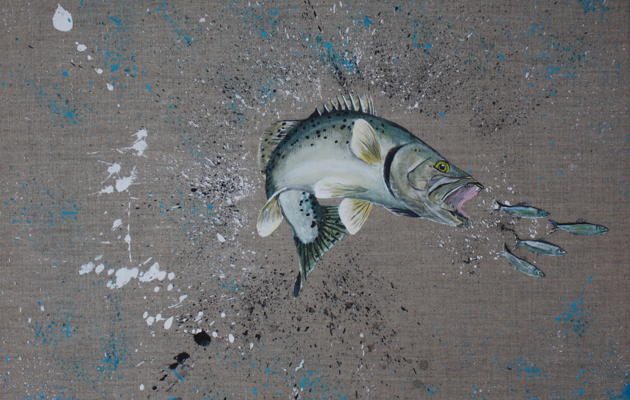Jack Fetherstonhaugh is making a splash in more ways than one. He tells Janet Menzies how he deals with the more diva-like of his subjects
Having developed his own techniques, Jack Fetherstonhaugh captures his subjects in unique ways. He explains to Janet Menzies his long process to capture tone, why watercolours remain his first love – and how to deal with the divas.
For more sporting artists, Christopher Marshall explains how time and technology allow him to capture his canine portraits. And Justin Tew paints compelling and nostalgic seascapes, and now his concerns for marine conservation are informing his work.
JACK FETHERSTONHAUGH
There is a disarming honesty about the work of Jack Fetherstonhaugh. His horses are the type that have their noses kissed rather than performing pirouettes and piaffes. A spaniel, frankly, could do with grooming and a terrier glares out of the canvas with a belligerent stare that says: “I have either just been up to something or am about to be.” Fetherstonhaugh confirms this was indeed the case: “That was Bella, a very troublesome dog. That dog would not sit still for a second. In the end we had to photograph her with someone holding her down on the bench. And the family’s toddler was running off and the removal men were in. It was chaos. But that was one I really enjoyed doing, and I think it is one of my best.”

Commissioned work of a pheasant.
Fetherstonhaugh has developed an interesting technique for this series of portraits. “It is quite a process to make them. I usually start with a photograph, which I put into negative and then print. Then I photocopy the print and that has a graininess and texture to it, which shows me where the tones are – I might then re-photocopy the copy to increase that. Then I trace over the image onto the surface and start putting paint down, using about five or eight tones of grey. It’s very time consuming.”
Though Fetherstonhaugh now paints mainly in acrylics, watercolours were his first love as he spent his childhood painting local landscapes. Even though he did little else, he says: “I never thought I was going to be an artist.” But in his early twenties he developed chronic kidney failure, which has resulted in a continuing need for dialysis. At the same time he found himself more and more drawn to painting.
“I was rather enjoying working for an antiques dealer when a family friend offered to give me an exhibition. I said no, but after a long Sunday lunch and a glass of red wine I was persuaded. It was a frantic few months work to prepare, but the exhibition was such a success I was able to become a full-time artist.”

The artist in his studio.
Fetherstonhaugh, 31, is currently still on the kidney transfer list and recently had two hip replacements. He comments in passing: “This has greatly improved my way of life; I even climbed a mountain last week. It has been a long fight with many ups and downs but I can honestly say that art, fresh country air and mindfulness have been greatly useful in keeping me motivated and positive.”
EXPLODING WITH LIFE
This is obvious from his work. His ongoing series Movement in Birds simply explodes with life and colour and vigour. Puffins plummet in to land, orange feet splayed out like traffic cones. Pheasants and partridges whirr across the hessian canvas in a trail of feathery paint splats. Parrots are simply dayglo flashes glimpsed from the corner of the eye. His paradoxical swans have a luminous grace, even as they crash from air onto water with a flurry of inelegant splashes.
It was trying to convey the instant of a swan’s landing that led Fetherstonhaugh to develop his Jackson Pollack-like technique. “I had prepared these massive black canvases, which was a lot of work, and I wanted to capture that moment when the swan breaks the water and it all splashes up. Eventually, I just grabbed the tube of white paint and squirted the paint straight out and luckily it went just right and I liked it.”

Three Ducks.
From then on Fetherstonhaugh began to paint more and more birds, gradually developing and adapting his technique to capture the unique qualities of each different species. He explains: “I am learning about how to flick the paint, and I use a toothbrush now – I have a pot of ordinary brushes and a pot of toothbrushes on my bench. You can convey so much by the different ways you flick the paint. I use acrylic, which can either be quite smooth or you can get a big blob of paint which has great texture. I love trying to capture the movement in birds. With the hessian canvas sometimes a blob of paint will just sit on top of the weave, and it helps make it three-dimensional, the image changes as you look. But I admit that if I’m feeling a bit precious I sometimes put a plate over the main image to protect it from unwanted splodges.”
Recently, Fetherstonhaugh has embarked on a series of fish paintings, including mackerel and salmon, and is enjoying adapting his technique to convey movement through water, as opposed to air. But of all his subjects, on land, sea or air, Bella the terrier remains the true diva.
Jack Fetherstonhaugh exhibits regularly, mainly in north Wales and Anglesey, and is preparing a range of home items for Christmas. Contact him on 07703 774089 to discuss commissions or visit:
www.jackfetherstonhaugh.co.uk





